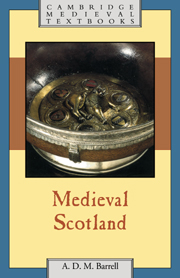Book contents
- Frontmatter
- Contents
- List of figures
- Preface
- List of abbreviations
- Maps
- 1 Early medieval Scotland
- 2 Feudal Scotland
- 3 The transformation of the Scottish church
- 4 The consolidation of the Scottish realm
- 5 The Wars of Independence
- 6 The Stewart kings
- 7 Crown and nobility in later medieval Scotland
- 8 The road to Reformation
- Conclusion
- Select bibliography
- Index
- Title in the Series
3 - The transformation of the Scottish church
Published online by Cambridge University Press: 05 June 2012
- Frontmatter
- Contents
- List of figures
- Preface
- List of abbreviations
- Maps
- 1 Early medieval Scotland
- 2 Feudal Scotland
- 3 The transformation of the Scottish church
- 4 The consolidation of the Scottish realm
- 5 The Wars of Independence
- 6 The Stewart kings
- 7 Crown and nobility in later medieval Scotland
- 8 The road to Reformation
- Conclusion
- Select bibliography
- Index
- Title in the Series
Summary
The late eleventh and twelfth centuries witnessed one of those periods of spiritual revival and renewal which have characterised the Christian era. Great churches were built to magnify the glory of God, and religious houses were founded in considerable numbers throughout Europe, many of them espousing new monastic rules which aimed to return their communities to a purer, more ascetic form of life and worship. The church also became more self-confident: successive popes and reforming bishops strove to reduce the influence of secular powers in ecclesiastical appointments and the control exercised by laymen over church property, and the papacy became an important player in its own right in the political controversies of the period. There was also a degree of reorganisation in the church's administrative structures, with dioceses being created and the parochial system becoming more widely and firmly established.
Scotland was not immune from these developments. The twelfth century saw the re-emergence of a diocesan structure throughout the realm and the establishment of several major monasteries, and through the efforts of reforming churchmen and their royal or lay patrons attempts were made to bring the practices of the Scottish church into line with the rest of western Christendom under the supervision of an increasingly active papacy. Even if two Scottish prelates who attended the Third Lateran Council in 1179 cut unimpressive figures, there can be no doubt that by this date Scotland was very much part of the universal church.
- Type
- Chapter
- Information
- Medieval Scotland , pp. 42 - 66Publisher: Cambridge University PressPrint publication year: 2000



